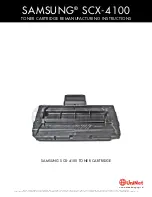
Appendix B: Windows 2000/XP Host PC Software Installation
¤
2005-2010 SR Research Ltd.
83
viii. Copy these files to the root directory of the EyeLink 1000 drive on your
computer.
3. To return Windows so that it hides operating system files complete the following steps:
i.
Select the Tools
o
Folder Options… menu in Windows Explorer.
ii.
Select the View tab.
iii.
Deselect the “Show hidden files and folders” option under Hidden files and
folders.
iv.
Check the “Hide protected Operating system files….”
4. If you have a PS/2 keyboard please continue to section “11.6, Transfer the System to
make the EyeLink Partition Bootable”
11.5
Configuring the Keyboard
The PS/2 keyboard is the default driver setup within the EyeLink Host directory, and is the
only keyboard hardware recommended for the latest versions of the Host Application.
11.6
Transfer the System to make the EyeLink Partition Bootable
1. Insert the CD labeled “ROM-DOS Boot Disk” that came with the EyeLink 1000 system,
and restart the system as you normally would via Windows. The next step is to boot off
of the CD. You may need to press F12 before System Commander is run to boot off of
the CD-ROM device. With some newer types of hardware choosing to boot from the CD-
ROM from within System Commander does not work as desired.
2. You will know that you have successfully booted from the CD-ROM of you are given a
ROM-DOS command prompt.
IMPORTANT: The following step requires you to determine the correct drive
letter (c:, d:, etc) for the EyeLink 1000 partition you created above after
booting with the ROM-DOS Boot Disk. Determine this by using the
dir
command
(
e.g.
dir c:)
for each drive to find the EyeLink drive label and
substitute that drive letter (c:, d:, etc) in place of {EYELINK DRIVE} below. It
is likely that the drive letter will be either c: or d:
3. At the command prompt
'A:\>’
type the following command:
sys {EYELINK DRIVE} [ENTER]
For example if your EyeLink partition is drive c: you will enter:
sys c:
and then press the enter key.






































